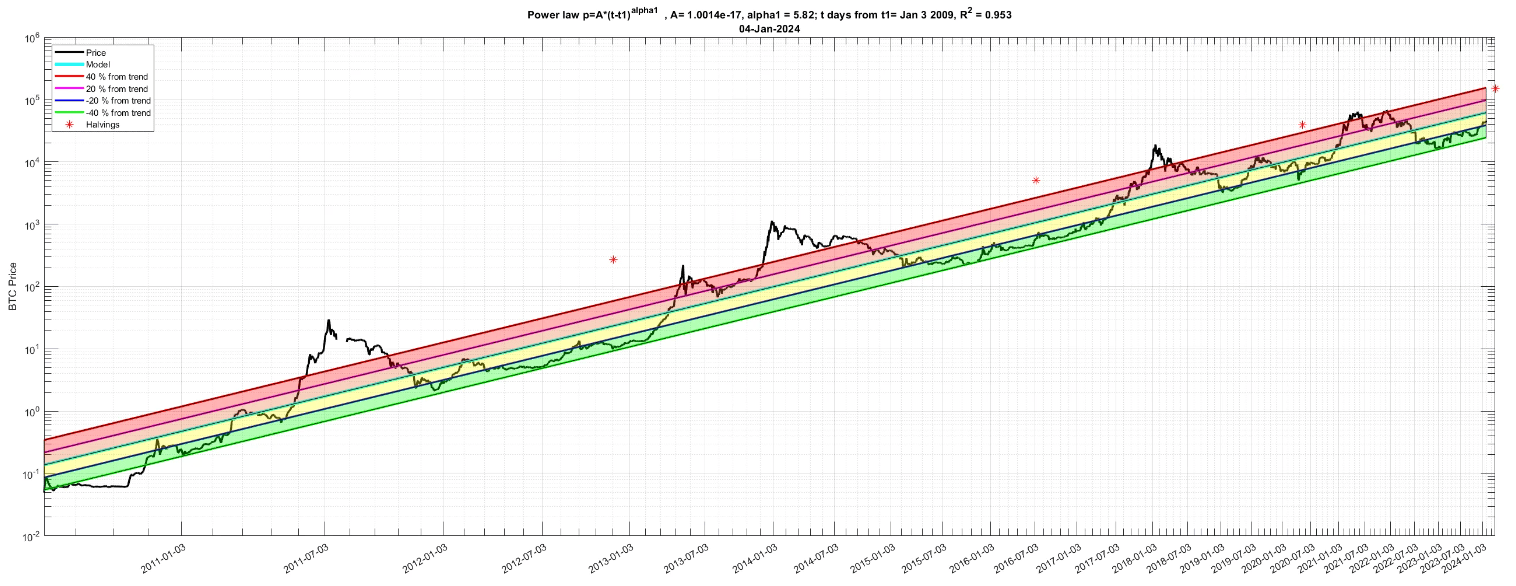News - Why Bitcoin could rise to a million US dollars
The price of the Bitcoin seems unpredictable. However, a physicist claims to have found a formula according to which the cryptocurrency is destined to rise to a million dollars.
Sometimes you can only marvel at mathematical correlations. Why there cannot be a bigger animal than the blue whale, why King Kong could not support his own weight, or the relationship between the orbital period of a planet and its distance from the sun: these can all be explained using power laws, without empirical evidence, just the power of logic. Such a scheme can also be applied to Bitcoin. With great promise: If the theory proves true, a Bitcoin should be worth a million dollars in 10 years. How realistic is the Bitcoin price prediction?
Bitcoin worth a million dollars in 10 years?
Weather forecasts like to leave you standing in the rain. Climate change in the coming years, on the other hand, can be calculated fairly accurately. According to physicist Giovanni Santostasi, the situation should be similar to Bitcoin. A few years ago published he theory that value evolution can be predicted using power laws. The model is currently in the spotlight again. According to Santostasi, it is currently clear "that BTC continues its behavior according to power laws with a similar exponent."
In retrospect, the model has been "frighteningly accurate" for the past 15 years, says YouTuber Andrei Jikh in a video with more than 300,000 views. Bitcoin follows "a specific mathematical model," he explains. The price trend fits this model perfectly. If you look at the trend so far, the price is exactly framed between resistances and support points. Small fluctuations, such as when it rains even though the weather app shows bright sunshine, are ruled out: In the long run, the pattern seems to hold.
Source: Reddit
Moving forward, there is no escaping the fact that Bitcoin is climbing to ever new highs. The initial jumps are still relatively moderate. By the middle of next year, the price should be somewhere between US$150,000 and US$200,000. That's still about three times its current value. But nothing compared to the prospect just under a decade from now. By 2033, in July to be exact, Bitcoin "should be at a million dollars," Giovanni Santostasi said in an interview with Andrei Jikh.
"95 percent" correct
And without alternative security. If you put the model to the test, he seems to have good reasons for that. From zero to one, up to ten, a hundred dollars, a thousand: the "concept of scale" has worked so far, Bitcoin follows the pattern which is "95 percent" correct, according to Santostasi. No other asset, he says, can be calculated as correctly as Bitcoin. But is that enough to carry it over into the future?
If you want to see patterns, you will find them. Especially when the time period is as short as Bitcoin's: 15 years of data. Enough to use as a template, but not enough to make predictions. According to Santostasi, the fact that gold and the S&P 500 did not show the same regularities as Bitcoin may also have to do with the fact that they were analyzed over longer periods: 35 and 70 years.
Theorem with X
How careful you have to be with such models is shown by another model that is widely used - and has failed miserably despite several rescue attempts: the stock-to-flow model. It places the rise in value in a causal relationship with the constant supply shortage, which is programmed by the recurring halves. If the model were correct, the Bitcoin price would have reached $100,000 by the end of 2021.
Stock-to-flow is really not looking good now.
— vitalik.eth (@VitalikButerin) June 21, 2022
I know it's impolite to gloat and all that, but I think financial models that give people a false sense of certainty and predestination that number-will-go-up are harmful and deserve all the mockery they get. https://t.co/hOzHjVb1oq pic.twitter.com/glMKQDfSbU
Santostasi alludes to this indirectly when he says his method differs "from other graphs." The graph is "not linear," the scientist explains: "It may be exponential over a few years, but it doesn't follow a clear pattern over 10 years. If you see a linear trend in a logarithmic graph, you are dealing with a power law, not an exponential curve." He had not seen any other model "that clearly shows this behavior of the power law."
Can Bitcoin overtake China?
Calculus has its charm, but also its flaws. It interprets the price trend, which is influenced by numerous random factors, as predetermined, or in religious terms: predestined. And thereby exposes itself to the danger of drawing the wrong conclusion, deriving universally valid conclusions from individual events.
How astronomical such an increase in value would be can be visualized with a mathematical example. The amount of Bitcoin in circulation in 2033, in July to be exact, is 20,721,052 Bitcoin. At an exchange rate of one million dollars, this would result in a market capitalization of about $20.7 trillion. About six trillion more than the current market capitalization of gold. And just between the gross domestic product of the world's largest economies: China and the US. And the end of the road has not yet been reached. According to the model, in about 20 years the price should be at $10 million. With a market capitalization that would then be twice the gross domestic product of the entire world.
Ethereum inventor Vitalik Buterin once said of the stock-to-flow model, "I know it's rude to gloat, but I think financial models that give people a false sense of security and predict that numbers will go up are harmful and deserve all the ridicule they get." I wonder what he would have to say about these predictions?







